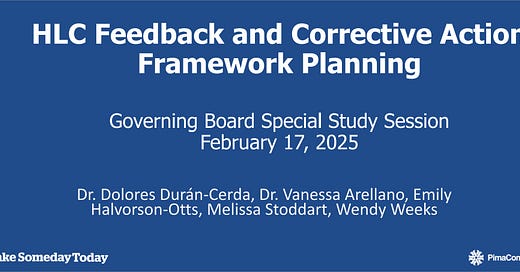🔍 Pima Community College's HLC Report: Uncovering the Compliance Cracks
Examine the challenges in delivering equitable education across Pima's diverse learning environments.
😽 Keepin’ It Simple Summary for Younger Readers
👧🏾✊🏾👦🏾
🔟 years ago, Pima Community College was in big trouble 🚨 and might have closed because they had a lot of problems, like leaders being unfair ❌ and not following rules. But now, they've worked hard to fix these problems 🔧 so students can have good and fair teaching 📚 no matter where they learn. The college still has some things to fix, like making sure all classes are taught well 👩🏫 and getting good teachers, but they are on the right path. 🌟
🗝️ Takeaways
🔄 Transformation Journey: Pima Community College has moved from probation in 2013 to a path of resilience and accountability by 2025.
❌ Past Failures: The college once faced severe issues, including corruption, ethical breaches, and mishandling of serious allegations.
🏫 Educational Reach: Serving students across various locations, Pima struggles with curriculum quality and consistency.
👩🏫 Staffing Problems: Finding qualified instructors for diverse sites remains a significant challenge.
📈 Data Utilization: Despite being data-rich, Pima is working to convert data into actionable insights for student success.
💸 Financial Burden: Compliance comes with significant costs, impacting the college's budget.
🔍 Commitment to Improvement: The institution aims to enhance communication, accountability, and consistency.
🤝 Community Engagement: The report encourages community involvement to ensure transparency and equity.
Inside Pima Community College's HLC Report at the February 2025 Meeting
From Probation to Progress: A Decade of Transformation
To understand the significance of the 2025 Higher Learning Commission (HLC) report, one must first look back to 2013—a pivotal year when Pima Community College was placed on probation, facing a crisis that threatened its very existence. The accreditation challenges revealed deep-seated institutional problems that would require a fundamental reimagining of the college's governance and culture.
In April 2013, the Higher Learning Commission delivered a scathing critique that shook the institution to its core. The probation was not just a bureaucratic slap on the wrist, but an indictment of systemic failures that included:
Corrupt contracting practices
Mishandling of sexual harassment allegations
A toxic leadership culture characterized by "fear and retribution"
Ethical breaches at the highest levels of administration
The investigation centered on several key issues, most notably the resignation of Chancellor Roy Flores after eight women accused him of sexual harassment dating back to 2003. The governing board—including members Brenda Even, Scott Stewart, David Longoria, and Marty Cortez—was heavily criticized for its leadership failures.
At the time, the stakes were existential. While students' immediate academic futures were not in jeopardy, the college faced the very real possibility of losing its accreditation if it failed to address the systemic issues identified by the HLC.
Fast forward to 2025, and the current HLC report represents a remarkable journey of institutional transformation. What was once a story of institutional failure has become a narrative of resilience, accountability, and committed change.
When Chancellor Jeff Nasse addressed the Governing Board, his words carried the weight of this hard-fought journey: "We just need to ensure that we're offering a class at whatever high school that is at the same quality, we're giving college credit." This simple statement is a testament to the college's arduous path from potential closure to renewed institutional integrity.
In the complex world of higher education, accreditation is more than just a rubber stamp of approval—it's a critical mechanism that ensures students receive quality education. The 2025 HLC report for Pima Community College is not just another bureaucratic document; it's a revealing X-ray of the institution's educational ecosystem, exposing both its strengths and the critical fissures that still need attention.
For the average student, parent, or community member, this report might seem like dense technical jargon. But at its core, it's a story about fairness, consistency, and the fundamental promise of education: that every student, regardless of where they learn, deserves an exceptional educational experience.
The Landscape of Learning: Pima's Educational Reach
Pima Community College operates an extensive and diverse network of educational sites:
28 total approved locations
15 dual enrollment high school sites
3 prison education programs
Multiple community training centers
Specialized training facilities
Imagine a student taking a course at a high school campus, another at a community center, and a third at the main college campus. Should their educational experience be any different? The HLC says absolutely not—and herein lies the problem.
Understanding Additional Locations
Melissa Stoddart, Director of Additional Location Compliance, provided crucial context: "An additional location is where we're offering credit courses and we're exceeding more than 50% of a degree certificate or other recognized educational credential. This can be a facility that the institution does not own—an office building, a high school, or a campus on another institution."
Key Areas of Concern: What the HLC Discovered
Curriculum Quality Challenges
Wendy Weeks, the Accreditation Liaison Officer, outlined the primary concern: "We want to make sure we are offering our curriculum and programs with quality wherever we offer them—whether at additional locations, dual enrollment high schools, in classrooms, online, or in hybrid formats."
The learning management system (D2L) exemplifies these challenges. While it should be a uniform platform connecting students and faculty across all locations, the HLC discovered that many sites were not fully utilizing this critical tool.
This isn't just a technical issue—it means students at different locations might have dramatically different access to course materials, communication with instructors, and learning resources.
The Staffing and Qualification Dilemma
Emily Halverson-Otz, Acting Vice Provost of Academic Access, highlighted a critical issue: "One of the most significant challenges to our dual enrollment sites is finding qualified instructors that meet our minimum criteria for certification."
This challenge reveals deeper systemic problems:
Limitations in finding qualified instructors
Variations in teaching standards across locations
Potential compromise of educational quality
She elaborated that staffing limitations often dictate what courses can be offered, creating a ripple effect of educational inequity.
The Data Challenge: From Information to Impact
Vanessa Arellano, Director of Provost's Office Initiatives, was candid about the institution's data challenges:
"We have plenty of data. We are, in fact, data-rich. What we need to do is really come up with a plan to analyze the data and also be able to utilize that data to create a meaningful impact when it comes to student learning."
Real-World Consequences
The most striking revelation came from Halverson-Otz: "We've had students who actually earned a degree or certificate, but because they were not in a program of study, they didn't actually earn it."
This single statement illustrates how administrative complexities can directly undermine student achievements.
Financial Implications and Institutional Costs
The compliance challenges come with significant financial considerations:
Approximately $50,000 to manage each additional location
Annual billing for location maintenance
Roughly $15,000 per HLC site visit every four years
Melissa Stoddart was transparent about these realities: "Anytime we file for an additional location, we pay money. We are billed yearly to maintain that additional location."
The Path Forward: Institutional Commitment
Chancellor Nasse acknowledged the challenges: "Some of this is a large college serving across the county in different spaces. That's where some of that consistency and accountability has broken down."
The institution's proposed strategic focus includes:
Enhanced communication
Increased accountability
Consistent implementation
Data-driven decision making
Community Call to Action
How can you get involved?
Attend Governing Board meetings
Request detailed compliance reports
Support student advocacy initiatives
Demand transparency in educational processes
Questions for Community Reflection
How can we ensure educational equity across different learning locations?
What mechanisms can we develop to more effectively track and support student success?
Final Thoughts
"We are working to bridge silos, improve communication, ensure accountability, and maintain consistency across all our educational locations." - Emily Halverson-Otz
Disclaimer
This analysis is based on the February 17, 2025 Pima Community College Governing Board Study Session meeting and HLC report.
Leave your thoughts, experiences, and insights in the comments below.
About the Analysis
Prepared by a local education watchdog committed to institutional transparency and student success.






